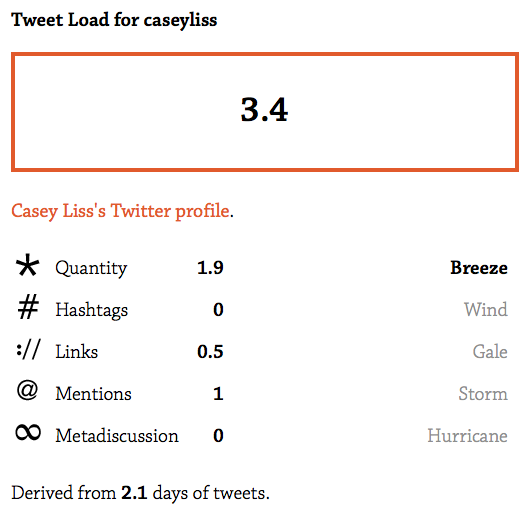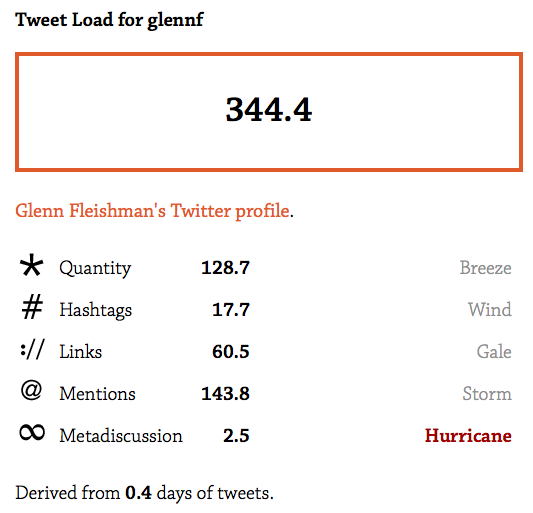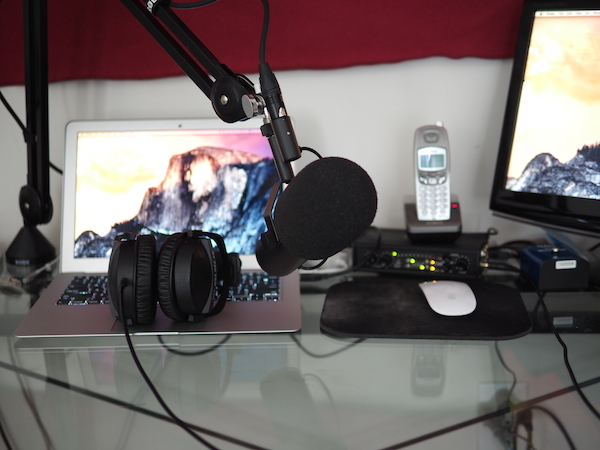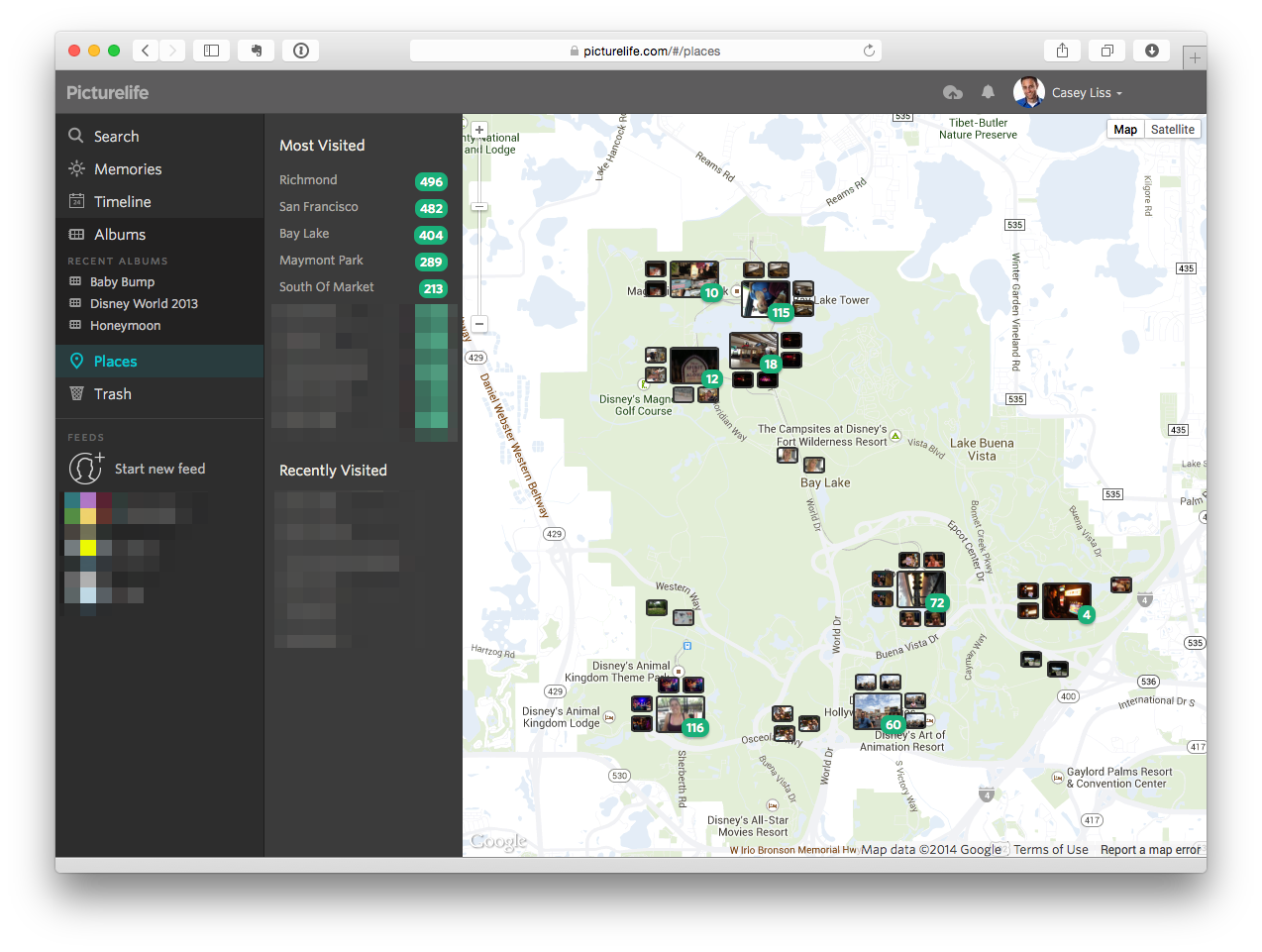Not just a Monty Python reference (hi John!), Unladen Follow is a very neat tool by my pal Allen Pike. It computes, as best it can, how burdensome following a new Twitter account will be. This allows you to avoid the regretful unfollow by deciding before you follow someone whether or not they will clog up your timeline.
Here is me, for example:

For comparison, here is notorious perpetual tweeter Glenn Fleishman:

I had discussed a tool very much like this on Analog(ue) #17. I knew that Allen had written something like this in the past, but erroneously believed that he had retired it. Unladen Follow is actually quite a bit more than I wanted — it is far more complex, considering many annoying Twitter faux pas in order to assign a Tweet Load score.
You can optionally choose to log into Twitter using Unladen Follow, and it will report to you which of your follows has the highest Tweet Load Units.
Unladen Follow is a great example of why having a robust API can allow for tools that improve your platform, not hinder it.
My pals over at Studio Neat recently released a stop-motion video that explains how to use their Simple Syrup Kit. It’s a really fun, short video:
Dan describes the motivation behind using stop motion:
There are two things that I love about stop motion. It is super approachable; a five-year-old could make a stop motion movie. The other thing I love is, inherently, you see the creator’s hand (not literally) in the work. The visual of stop motion somehow allows you to understand it was crafted by a person, painstakingly.
On their blog, Dan explains how they did it. It’s a really interesting post about how simple-yet-tedious techniques can produce really interesting results. Don’t miss the video at the end, which is an unedited version that shows you how they made syrup shake in mid-air, and pens write all on their own.
I love Christmas music. Naturally, I enjoy all the classics like Burl Ives and Mannheim Steamroller. But over the last couple years, I’ve found a quartet of albums that I really enjoy, and you may too:
-
Pentatonix - PTXMas
Amazon - Apple Music - iTunes - Spotify
An amazing quintet that got their start on reality TV, Pentatonix’s first Christmas album is excellent, and amazing considering all the music comes from five voices. My favorite track is “Carol of the Bells”. -
Pentatonix - That’s Christmas To Me
Amazon - Apple Music - iTunes - Spotify
Released this year, Pentatonix’s follow-up Christmas album may be even better than their last. My favorite track is “Mary, Did You Know?”. -
Pentatonix - A Pentatonix Christmas
Amazon - Apple Music - iTunes - Spotify
I’ve come back from the future to amend this post, and add the new-for-2016 A Pentatonix Christmas. You can see a theme here, for sure, but I really love Pentatonix’s Christmas albums. They’re appropriate in almost any sort of social gathering, and the music is phenomenal. On this album, my favorite track is “Hallelujah”. -
Family Force 5 - The Family Force 5 Christmas Pageant
Amazon - Apple Music - iTunes - Spotify
Definitely not for the faint of heart, Family Force 5 is a “crunk rock” band. I’m old, so I don’t know exactly what that means, but their takes on classic Christmas songs are a ton of fun. I’ve had this album on heavy rotation since Jason Alford introduced me to it a few years ago. My favorite track is, unsurprisingly, “Carol of the Bells”.
So, check out the above, and I think you’ll find your Christmas will be just that much sweeter.
UPDATED 30 November 2016 8:30 AM: Updated links to remove Rdio & Beats; added A Pentatonix Christmas.
Here in Richmond, Virginia, we take our Christmas lights seriously. Really seriously. It is a local tradition to go out with a group of friends or family, and look at all the ridiculous Christmas lights that local homeowners put up. We call this a “Tacky Lights Tour”.
Professional tour-goers, like your humble author, will often get together a bunch of friends so that it’s affordable to hire a limousine. Doing so allows everyone to safely enjoy their lights with their holiday beverage of choice. Though to be honest, I’m even more excited to do a family trip with Erin and Declan this year.
Does this seem a bit silly? Maybe. Before you judge, check out this awesome example from last year:
Not enough? You can try this. Or this. Or this.
You get the idea.
Last year, rather than taking a limo, we rented a minivan. I was the designated navigator. I wanted an easy way to navigate between houses that I can use on my iPhone. I ended up writing a single-serving page that simply has a list of all the addresses you want to visit. If you tap on any address on your iPhone, it will open Apple Maps and route from your current location to that address.
In preparation for this year’s tour, I just updated my local copy. In doing so, I thought the page may be of use to others. I originally posted about it on Tumblr last year, but I thought I’d mention it again here.
You can see the source for my Tacky Lights Navigator here. Edit it for the houses you select from the official list, post it somewhere you can get to from your iPhone (such as Dropbox), and go (safely) enjoy those tacky lights!
Ever since I can remember, I’ve always admired the Make a Wish Foundation. Their goal is to make sick children smile and forget about their potentially terminal illnesses — if only for a short while.
In the last couple years, as I’ve gotten to know my friend Stephen Hackett better, I’ve come to appreciate the Make a Wish Foundation even more.
This morning, one of my favorite TV shows, CBS Sunday Morning, did a feature on the Make a Wish Foundation. It’s well worth watching, or if you prefer, reading the associated article.
There is a Flash-free version of the video available on CBS’ site.
In my post about my podcasting equipment, I discussed my setup. I also recommended the Rode Podcaster Booming Kit as a great starter setup. At around $350, it is absolutely a lot of money.
Some readers took issue with this. I can’t fault anyone who did.
As with anything audio-related, it is possible to spend a lot of money on your setup. Furthermore, audiophiles (particularly ones that disassociate themselves with the term) love to come out of the woodwork to criticize your setup. More often than not, this is not helpful. I worry that my post came across exactly that way.
Jason Snell weighed in on his site, and I completely agree with him. In particular:
I once spoke on a podcasting panel at a Doctor Who convention. When I made what I thought was a reasonable suggestion—the $50 Blue Snowball as a starter microphone—large swaths of the audience cringed. These were people with no money for such things. They were interested in podcasting, but the idea of spending $50 on a microphone was just too much.
There are two ways to react to that moment. One is to suggest to that group of interested, creative people that if they aren’t committed enough to podcasting to pay $50 for a microphone, they shouldn’t bother. The other is to encourage them to use the tools at hand to find their voice. Improving the quality of the sound can come later—and the more they come to love podcasting, the more they’ll want to spend (in terms of time and money) to make their podcast sound better.
Don’t let the quality snobs — including me! — get you down. Use whatever you can, even your earbuds, if you have to. The point is what you’re saying, not how it sounds.
Our fancy new camera allows for uploading of GPS information by way of a companion iPhone app. However, it requires the presence of mind to start position logging in that app before you start taking pictures. I often forget.
Since I love having robust metadata in my pictures, I want to be able to tag items in bulk upon removing them from my camera, even if I forget to tag them as I’m taking them. This allows for me to, among other things, look for pictures based on where they were taken in apps such as Picturelife:
Generally, I don’t care about hyper-accurate geolocation information; I just want to know which pictures were taken at our house, at my parents’, at Disney World, etc.
As expected, the good doctor had a solution.
My process is as follows:
- Go to Google Maps
- Find the location I’m looking for
- Right-click on the map, and choose
What's Here? - Copy the latitude/longitude from the popover in the upper-left hand corner of the map
- Plug in my SD card
- Grab a group of pictures that were all taken at the same location and move them into a staging folder
- Run Dr. Drang’ script on those images. For example:
~/coordinate.py -n 37.219980 -w 80.418054 *.JPG
The files in that staging area can now be processed. In my case, that processing — unsurprisingly — is also largely based on Dr. Drang’s work.
I should note that his script has quite a few dependencies. I found that, since I use
Homebrew, a couple of brew install commands (and a bunch of waiting)
was all it took to get what I needed.
My cohosts on both shows and I are often asked about our podcasting rigs. To be honest, there’s not a lot of magic behind what we do, other than really giving a crap. Much like a good photographer, a good podcaster isn’t defined by their equipment. Doubly so once you’ve reached something nicer than a phone’s camera, or a phone’s earbud microphone.
I’m not trying to justify any of this as the right nor best approach. I’m not saying that for your voice either of these microphones makes sense. I’m simply answering the question “What do you use?”.

Home Hardware
Beginning with ATP #92, I am now using the following, which Marco recommended to me:
Shure SM7B microphone- Shure BETA 58A microphone
- Shure A58WS-BLK windscreen
- Rolls MS111 MicSwitch mute switch
- Sound Devices USBPre2 preamp
- K&M Reducer Bushing to fit the Shure on the Rode arm (see below)
- 1 6-foot XLR cable to go from mic to switch
- 1 3-foot XLR cable to go from switch to preamp
I also continue to use a couple items from my original setup:
- Beyerdynamic DT 770 Pro 32Ω headphones
- Rode PSA1 boom arm
UPDATED 2015-05-04 10:00 AM: As of ATP #112, I have switched to using a Shure 58A ball-style microphone. This mic does a great job of eliminating nearly all background noise and works well with my voice.
Mobile Hardware
For nearly the first two years of my podcasting career, I used a different setup at home. This has now been demoted to my mobile rig, in the rare occasion when I want to record while traveling.
If you’re just getting into podcasting, I can’t recommend the Rode Booming Kit enough to get you started at home. You’ll sound professional without (completely) breaking the bank.
An alternative, which John uses and the Wirecutter recommends, is the Shure PG42-USB. It’s basically the same money as the Rode Podcaster, but it comes with a shock mount, pop filter, and desk stand.
For me, this is my mobile setup:
- Rode Podcaster Booming Kit, which includes:
- Rode Podcaster microphone
- Rode PSA1 boom arm
The arm came with this kit but, naturally, isn’t used while mobile. It instead remains part of my permanent setup. - Rode PSM1 shock mount
- On Stage DS7200B microphone stand
- IMAGE Pop Filter
Software
The software I use isn’t that exciting. As many others do, I wish there was something purpose-built for podcasting, but there isn’t yet.
- Skype to actually call each other
- Skype Call Recorder to record both ends of the call in separate tracks
- Piezo to record both ends of the call, usually for redundancy
Additionally, I’ll also have open while recording:
- Google Docs for show notes
- Colloquy for the chat room
- Caffeine to prevent my screen from ever sleeping
When doing my side of the edit (more on this below), I simply use QuickTime Player and TextEdit to take notes.
Workflow
Generally speaking, for ATP, the workflow is as follows:
Wednesday Night: We record the show
Thursday: Marco merges the tracks and does a rough edit. This includes cutting out crosstalk. Sometimes cutting cross-talk means muting one of us. Sometimes it means spacing out what we say so instead of being simultaneous, we’re now taking turns, thanks to the magic of editing.
Marco will also insert sound effects for swear words, as well as occasionally add some editing flair all his own. He will cut whole segments that are uninteresting or not worth including in the released episode. Finally, he adds the theme song and picks out pre- and post-show clips, and adds them in the appropriate places.
Friday Morning: I listen to the show, at 1x, and take note of any edit points I think he should consider. This is usually background noise like someone sipping a drink, or dropping something. Very occasionally, I’ll ask him to edit for content, on behalf of any one of us.
While I’m doing the edit, I also write a draft of the show notes in Markdown using
Squarespace’s editor. We really do host ATP’s site on Squarespace. If you’d
like to try it out, you may find that offer code ATP will save you 10%.
Friday Afternoon: I send my edits to Marco, who makes final changes. He’ll upload the file to Libsyn, make any changes to the show notes, and then post the episode.
For Analog(ue), we follow the same general workflow. We record on Thursdays, I listen to the copy of the show from Call Recorder, and then get edits to Myke by Sunday morning. He’ll then splice together the pieces and post the show by Sunday evening. Myke also tends to handle curating the show notes, as he’s impossibly fast at getting links together while we’re talking.
Advertising
- ATP’s ad sales are handled by a third party.
- We manage what spots are bought, paid, available, and who is owed what using a custom and proprietary piece of software that Marco wrote.
- Analog(ue)'s ad sales are handled by the Relay team and were, for a time, in small part by The Midroll.
Where's the Magic?
Like I said above, nothing here is really magical. The magic for both shows is giving a crap.
Many of my podcasting friends think we’re nuts to insist on going through the episode and trying to cut out cross-talk, odd background noises, et cetera. They may be right — it may not be worth all the extra time and effort. I admire the fact that, in many cases, they can post their shows within a couple hours of airing. They give a crap about timeliness.
To us, though, we see it differently. We don’t give (as much of) a crap about timeliness. We’d rather have something that sounds the way we want it to. So, we take the time to do what amounts to three edits: one to splice things together, one to mark any garbage points, and one to clean up the garbage. I can honestly say that I think ATP and Analog(ue) sound the best among their peers. You may never be able to tell the difference, and that’s okay with me.
Each side has its advantages; it’s up to you to decide what you think is best for you and your show.
I debated all day whether to write this post.
I wasn’t sure if I had an angle, or if it is appropriate to call attention to something so sad.
Yet, here I am.
When Erin and I were going through our issues, it often seemed like we had it worse than everyone else. If you listen, you can hear that come through in the post. Nevertheless, we often reminded each other — even as we were on the verge of giving up — that we are very lucky. We’re lucky to have a roof over our heads, food on our plates, a great group of friends, and wonderful families.
We’re not the only ones that tried to keep the positive attitude in the face of adversity. My friend Stephen and his family have kept perspective even during really tough times:
I know we’re the lucky ones. I’ve seen way too many child-sized coffins over the last five years. Josiah has lost too many friends to [childhood cancer].
Our lives are busy, and I’m not very good at keeping up with old friends. In fact, there are only two friends that I can think of that I’ve held onto from when I was in elementary school. One, my dear friend Brad, I am lucky enough to be able to see every June when I go to San Francisco.
The other is Marco.
I’m not sure if I met Brad or Marco first, but I’ve known them both around the same amount of time. Considerably more than any other friends I have.
Today I read “Lost”, and was really saddened. I knew what was going on with our dear friends Marco and Tiff, but reading Marco’s post still makes me upset.
I admire, however, that they are putting this into the universe. It’s an extremely difficult thing to do. But most of all, I admire this:
We’re extremely fortunate to have one kid already — that’s infinitely more than a lot of people get, and I never forget that. And he’s awesome, which is even luckier.
When you’re in the heat of the moment, your perspective makes you think that your reality is so much worse than everyone else’s. As it turns out, there’s always something to be thankful for.
For the last few weeks, I’ve been beta testing a new feature from Heroku. The smart folks over at Heroku have enabled Dropbox integration for repositories hosted there.
While that may not make a lot of sense at first, it is in actuality an immensely powerful feature.
Being able to make changes to my repository — no Git client required — means I can make changes to my blog in my Dropbox, and those changes will propagate to Heroku. Furthermore, those changes will be automatically committed to my Git repository, as you’d expect.
This effectively solves my posting-while-mobile problem.
My mobile workflow is as follows:
- Open up a text editor that speaks Dropbox and Markdown. For me, that’s Byword.
- Add/edit the files that need updating
- Make sure those changes are saved to Dropbox
- Go to the Heroku Dashboard, find the app in question, and open the
Codetab - Add a commit message, and then click/tap
Deploy
All told, these steps are the approximate equivalent of performing a git commit and a git push.
It will cause your app to deploy itself using the changes you’ve made in Dropbox.
No ugly hacks required. That’s super awesome.
Finally, after I’ve pressed the Deploy button, when I’m back at my main workstation, I simply
git pull to synchronize my local git repo with the changes made in Dropbox.
Though to be honest, there isn’t a hugely compelling reason to continue to use Git directly.
Good problem to have.
